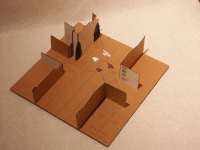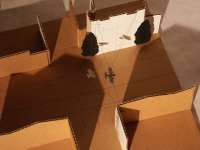Shadows, 1999: Two airplane silhouettes (15’ x 9’ and 10’ x 7’, respectively) will be hung between the airplane hangars at the former Sand Point Naval Air Station. The silhouettes, chosen from WWII airplane recognition manuals, are those of the WWII Grumann S2F-1 bomber and the 1929-30 Boeing Model 89 (XF4B-1) fighter plane; both were actually stationed at Sand Point. Their silhouettes will generate moving shadows along the street and against the walls of the hangars as the sun travels overhead. This artwork refers to the history of the facility at a time when it was an important component of our national defense system. It poses the question: friend or foe? Spotters and pilots have scanned the skies to distinguish friendly from foreign since the invention of the airplane. The shadow forms will be the most distorted near sunset as night approaches and clearest at midday. The slow movement of the shadows will animate the street throughout Seattle’s long (~ 16 hour) summer days.
Shadows, 1999: Two airplane silhouettes (15’ x 9’ and 10’ x 7’, respectively) will be hung between the airplane hangars at the former Sand Point Naval Air Station. The silhouettes, chosen from WWII airplane recognition manuals, are those of the WWII Grumann S2F-1 bomber and the 1929-30 Boeing Model 89 (XF4B-1) fighter plane; both were actually stationed at Sand Point. Their silhouettes will generate moving shadows along the street and against the walls of the hangars as the sun travels overhead. This artwork refers to the history of the facility at a time when it was an important component of our national defense system. It poses the question: friend or foe? Spotters and pilots have scanned the skies to distinguish friendly from foreign since the invention of the airplane. The shadow forms will be the most distorted near sunset as night approaches and clearest at midday. The slow movement of the shadows will animate the street throughout Seattle’s long (~ 16 hour) summer days.

